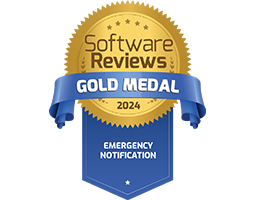Critical Event Management Software
What is Critical Event Management Software?
Critical Event Management Software is a powerful solution designed to help organisations prepare for, respond to, and recover from unexpected crises. It allows businesses to manage incidents such as natural disasters, cyber-attacks, security breaches, or operational disruptions in real time.
This software brings together a range of tools that simplify communication, coordination, and decision-making during critical events, ensuring a fast and organised response. Features like mass notifications, incident tracking, task management, and real-time analytics help organisations reduce risks, minimise damage, and ensure business continuity.
By automating and streamlining crisis management, this software not only protects people and assets, but also supports quicker recovery, reducing operational downtime and the long-term impact on the business.

How Crises Control's Critical Event Management Platform Can Help Your Organisation
Crises Control’s Critical Event Management Platform supports organisations throughout every stage of crisis management, from preparation to recovery.
1. Proactive Preparedness
Store and access customised crisis response plans in the cloud, helping teams prepare for emergencies and reducing confusion when a crisis strikes.
2. Fast, Clear Communication
Instantly notify the right people during a crisis, ensuring everyone is informed and can take action quickly, wherever they are.
3. Streamlined Incident Management
Track incidents in real time, assign tasks, and monitor progress to keep your response coordinated and effective.
4. Data-Driven Decision Making
Use detailed analytics and reports to assess the situation and improve your response for future events.
5. Business Continuity
Access the platform anytime, anywhere, on any device, ensuring your team can continue working even during a crisis, reducing downtime.
Crises Control’s platform helps organisations manage crises more efficiently, keeping people, assets, and operations safe while ensuring business continuity.
Measurable Business Outcomes
Transform your incident response capabilities and achieve tangible results with Crises Control
95% Faster Response Time
Reduce incident response time with automated alerts and predefined response protocols.
99.5% Uptime
Ensure business continuity with our highly reliable platform and redundant infrastructure.
100% Staff Reach
Achieve complete coverage with multi-channel communication and message escalation.
Reduced Risk Exposure
Minimise organisational risk with proactive incident management and compliance.
Data-Driven Insights
Make informed decisions with comprehensive analytics and reporting capabilities.
ROI Within 6 Months
Quick return on investment through improved efficiency and reduced incident impact.
FAQs
Critical Event Management Software helps organisations prepare for, respond to, and recover from unexpected crises, such as natural disasters, cyber-attacks, or operational disruptions. It streamlines communication, coordination, and decision-making, ensuring a rapid and organised response.
Crises Control’s platform helps by providing tools for proactive preparedness, fast communication, incident management, and data-driven insights. It ensures a quick response to crises, helps protect assets, and ensures business continuity even during a crisis.
Yes, Crises Control is cloud-based, allowing you to access the platform from anywhere, anytime, and on any device, ensuring your team can continue operations during critical events.
Crises Control can help manage a wide range of incidents, including natural disasters, cyber-attacks, security breaches, operational disruptions, and more.
Yes, Crises Control is scalable and can be tailored to fit the needs of businesses of all sizes and industries, from small businesses to large enterprises.
Crises Control follows industry-leading security protocols to protect your data, including encryption and secure cloud hosting, ensuring that your sensitive information remains safe.
Yes, Crises Control is designed to integrate seamlessly with a variety of other tools and platforms, including :
- Active Directory Integration
- Azure Active Directory Provisioning (SCIM)
- Single sign on (SSO) Azure AD/Okta
- Open APIs
- Fire detection systems
- CCTV monitoring systems
- Security monitoring systems
- Cyber threat monitoring systems
- Service desk systems
- IT alerting systems
- CRM systems
- HR systems
- Server monitoring systems
- Ticketing systems (ITSM
Yes, Crises Control solution is GDPR compliant.
Crises Control ensures its policies, processes, and procedures meet GDPR compliance requirements. We monitor GDPR Compliance requirements to ensure that the platform is meet and exceeds the standard.
[GDPR Compliance] [Technical & Security Resilience FAQs] [Accreditations]
You can create your Standard Operating Procedure (SOP) using our step by step SOP wizard to help you. The SOP wizard allows you to create your own bespoke Incident Action Plans (IAP) and link them to an Incident.
The SOP produced can have an assigned owner, version number, review date and review frequency and version control. When complete, these documents are can be stored in the Media Asset Manager where they can be accessed at any time.
iSOP Wizard is an extension of the Incident Manager module. It allows you to create your own bespoke Incident Action Plans (IAP). Each document produced has an owner, version number, review date and review frequency to allow effective version control. When complete, these documents are stored in the Media Asset Manager where they can be accessed at any time.
Business Continuity
Integrate Crises Control with other platforms such as ticketing systems, server monitoring tools, antivirus software, and more to enhance your business continuity functions.
Incident Management
When a crisis hits, use Crises Control to manage tasks, track progress, and keep response teams, employees, and other stakeholders informed, until the incident is over.
Alert Responders to Incidents and Tasks
Use Crises Control to alert response teams to an incident, allocate tasks, and report on progress. Gather performance data using automated auditing and inform post event learning and improvement.







